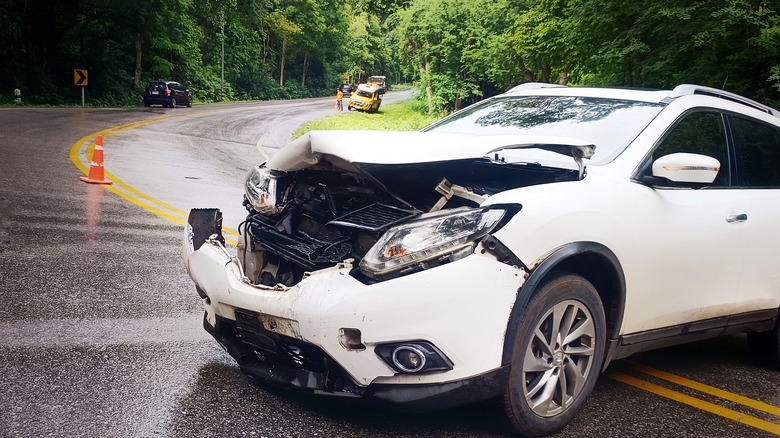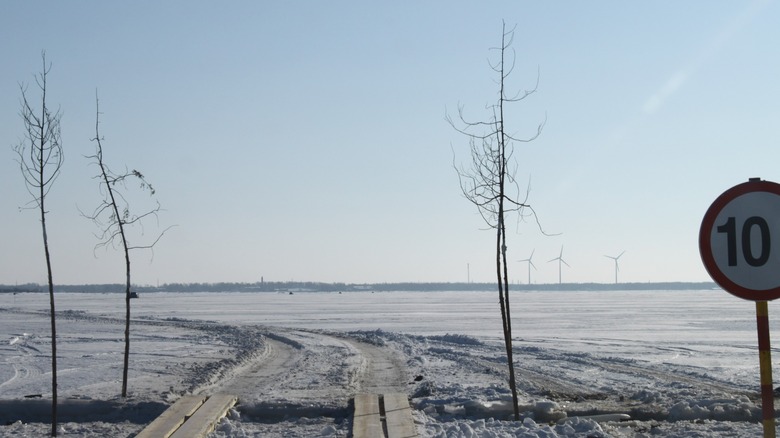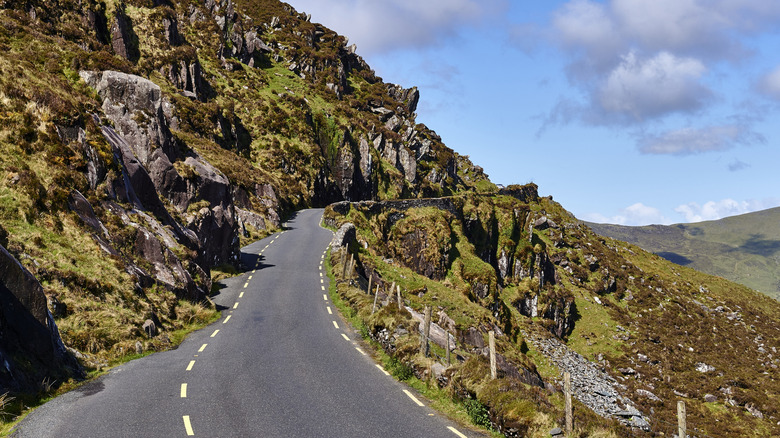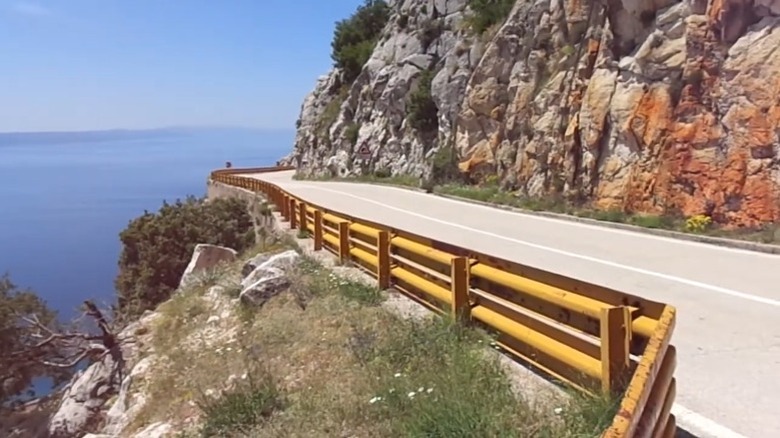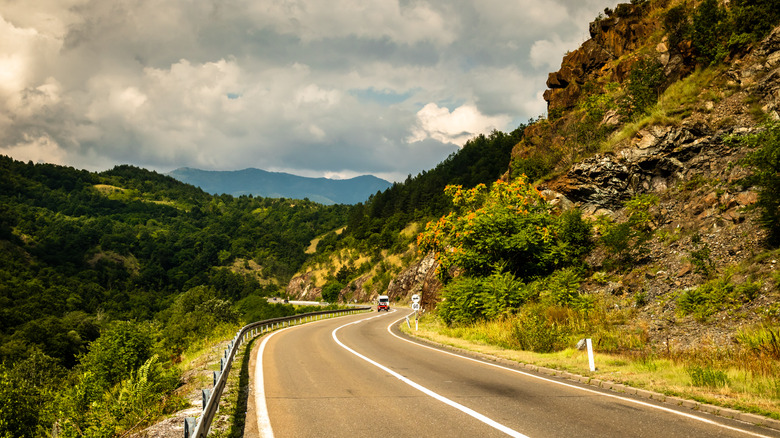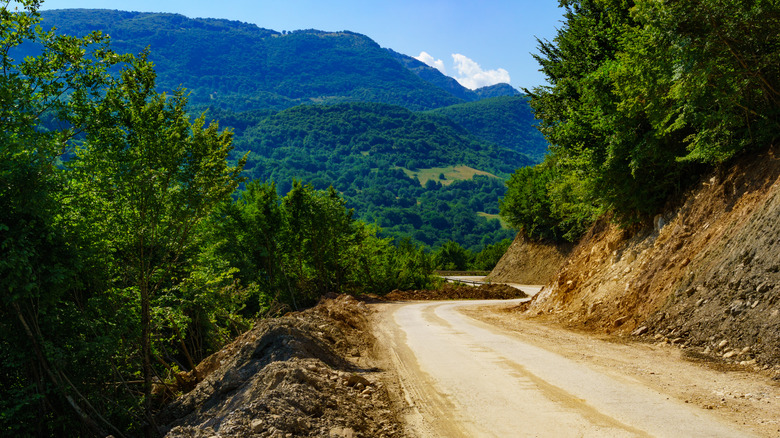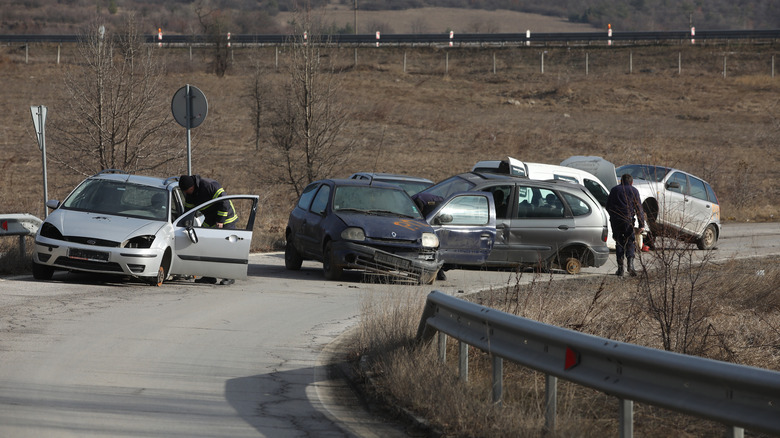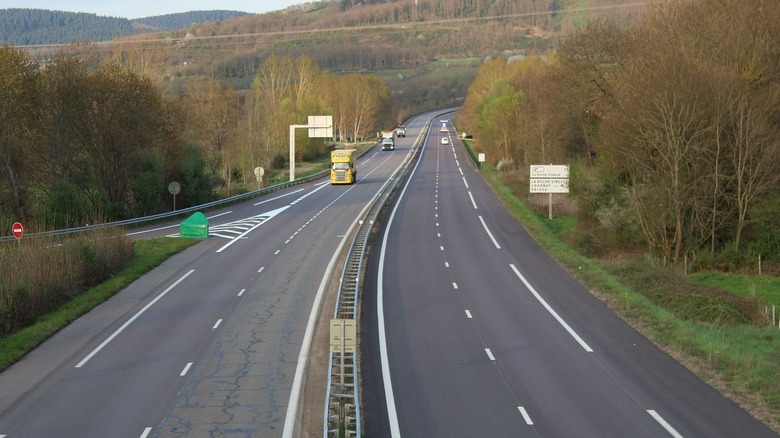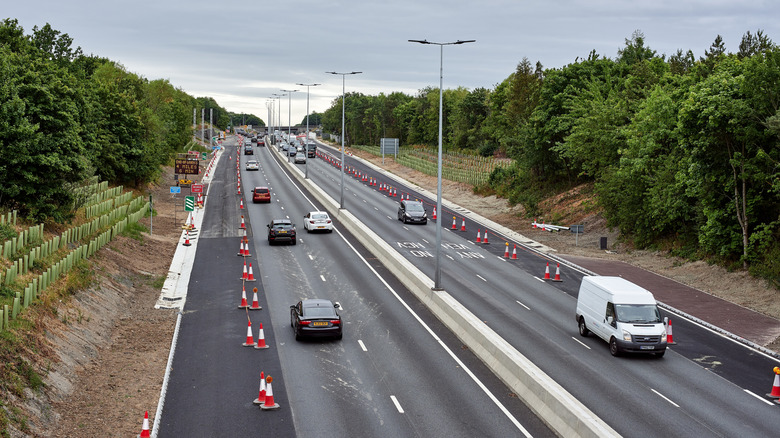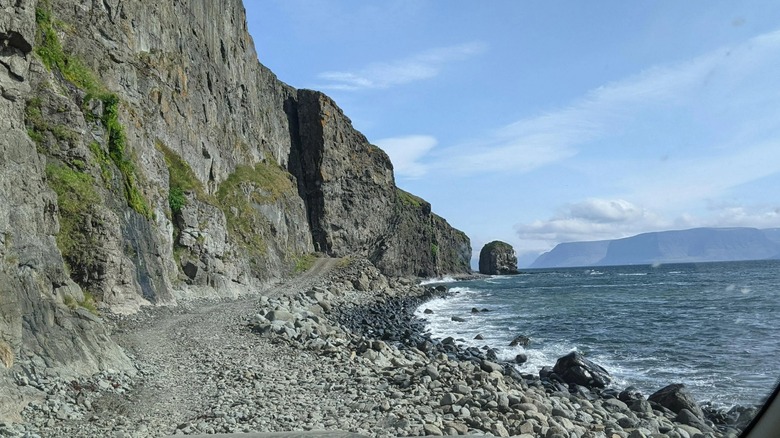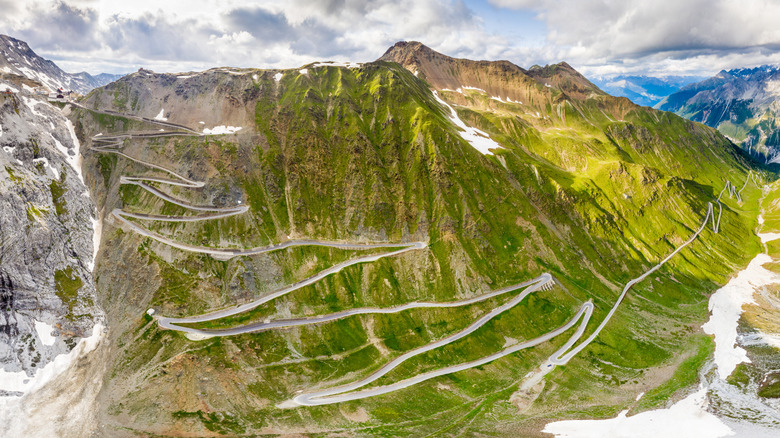The Most Dangerous Roads In Europe To Avoid For A Safer Vacation
Many travelers dream of going on a European road trip. Traversing the continent's highways and thoroughfares can bring you into contact with some of Europe's most charming small towns and villages. In many cases, once you're in the European Union, transitioning from one country to the next is essentially as simple and seamless as driving between U.S. states –- although not always.
This means that a grand adventure that begins in France or Belgium doesn't have to remain there. It might instead include mountain driving in Switzerland or a coastal jaunt in Spain or Italy. Or perhaps even a trip across the English Channel to catch London's nightlife (and a bevy of free activities in the U.K. capital). Indeed, Europe has many treasures just waiting to be explored by adventurous drivers on an international road trip.
However, not all roads are created equal, and a great many European driving routes feature plenty of danger. These result from poor maintenance or unavoidable roadway conditions like steep cliffs, narrow passages, and tight corners. As such, some European roadways demand you avoid a laundry list of hazards or remain extremely cautious while navigating. We have highlighted some of the most treacherous roads Europe has to offer and a few words of advice on how to tackle them safely or find alternatives.
The DN7C (Transfăgărăşan Highway) in Romania
The first road on this list is in a particularly dangerous country for drivers. Romania features a network of roadways that aren't particularly well maintained. A World Economic Forum survey ranked Romanian roads as 138 out of 140 in 2013. However, one of the most treacherous found there crosses a mountain range.
The Fagaras Mountains can be found roughly in the center of Romania and complete the southern portion of a ring that extends almost around the country's infinitely road-trippable Transylvania region. When the Soviet Union arrived by tank in Czechoslovakia, Romania's leader began exploring roadway options to support the defense of the country in fear of an invasion. Until this roadway was completed in 1974, there was no good way to move north into this part of the country.
The resulting mountain pass climbs to 6,640 feet and is curvier than straight. A snaking path sees drivers navigate a lengthy series of hairpin turns and perilous cliff edges. There are also quite a few long stretches of exposed roadway with no barrier to protect drivers who may veer too close to the edge. Furthermore, the road is unnavigable during certain times of the year and bad weather. Combine all this with a high level of traffic when the road is open, and you're looking at a hazardous mountain pass. Fortunately, because the passage isn't consistently open for travel, going around the mountains on Romania's E81 or 73A is also an option for today's drivers.
The Estonian Ice Roads
Estonia is a truly fabulous destination in the star-studded Baltic region tucked away in Europe's distant northeast. It holds a number of cultural icons explorers will be eager to sink their teeth into. As a result of its unique geography, Estonia is a coastal nation. Sharing a surprising commonality with tropical Pacific destinations and its colder compatriots, it features more than 2,300 islands. These landscapes are thrust into the Baltic Sea and peppered along Estonia's frigid coastline.
Importantly, crucial portions of this seascape freeze in the winter, providing a unique avenue of access to Estonian drivers. When the winter sets in, Estonians are able to head away to these island hamlets not by boat but in their cars. That's right; during the winter, the Estonian authorities have normalized driving on icy portions of the Baltic Sea that connect its islands to the mainland in a unique and exhilarating way.
But there's a catch. The ice is strong enough to support usage in this way, but drivers cannot stop their cars, and must stay between 16 and 25 mph. They must also remove their seatbelts to facilitate fast evacuation from a sinking car if the ice suddenly gives way. Ferries still shuttle visitors to some islands during the winter, but schedules are limited, and some destinations become unavailable. If you want to avoid the ice, your best bet is to visit in the spring or summer.
Irish local roads, particularly those like Conor Pass in Kerry
Ireland isn't generally known by travelers to be a dangerous place to visit. Perhaps it should be when it comes to exploring the Emerald Isle's roadways. The main urban areas around the country are connected to one another via national motorways. However, plenty of rural routes and local roads have been used by Irish drivers for generations ahead of these roadways' construction. The M7, for instance, was finished in 2010 (and started in 1983), connecting the east and west.
These smaller roads often provide a hugely rewarding scenic alternative, but the improved view comes at a cost. They are frequently single-lane affairs that weave through backcountry areas with reckless abandon, and drivers coming the other way down these roads won't always navigate slowly. You'll also notice the shoulder in the image above: That's added so cars can pass one another on roads.
It's reported that Irish local roads saw the biggest uptick in fatalities across Europe from 2012 to 2018. This is likely due to the fact that people who frequent country roads have come to know exactly where the twists and turns lie, as well as potholes and other hazards. Conor Pass is a particularly noteworthy drive. It features a narrow climb through the mountains with lots of blind corners and sharp turns. When heading anywhere in Ireland, there's often an alternative route. A drive to Dingle, for instance, can also be accomplished by heading toward Annascaul instead of taking the R560 through Conor Pass.
Croatia's State Road D512
The D512 is an elevated, coastal road that traverses the Adriatic seashore between Podgora and Makarska. However, the roadway also works its way inland as it moves farther south of these two coastal cities to connect with the D62 and E65. Explorers on a summer adventure throughout Croatia's island-hemmed coastline may be particularly tempted to hop on this 19-mile experience that combines winding, hilly terrain with spectacular views of the sparkling water below.
However, those worried about roadway safety might want to think twice about driving this stretch of Croatian highway. The road is paved, but it features a variety of curves that present a unique hazard when paired with the awe-inspiring views that surround it. Drivers will frequently be tempted to take their eyes off the road, a potentially deadly choice on even straight paths.
Naturally, during peak tourist season, there will be even more drivers yearning to experience the majestic sights of the region. Combine this with the fact that the D512 is sometimes stricken with landslides and other hazards present in mountainous regions, and you get a particularly dangerous stretch of highway that might be better avoided. If you're making a voyage along Croatia's coastline, opting for the D8, which more closely hugs the coast itself, can be a safer route that removes elevation from the drive.
State Road 22, a.k.a. Ibarska Magistrala or 'The Highway of Death' in Serbia
The "Highway of Death," "Black Highway," or Ibarska Magistrala (Ibar Highway), is known to be one of the most dangerous roads in all of Europe. The roadway connects Belgrade to a variety of other local areas across southern Serbia and eventually winds its way down toward Montenegro. Serbia is another country rated quite low on the World Economic Forum's roadway quality index, finding itself at 120 of the 140 countries evaluated.
Perhaps the most important thing to keep in mind if your chosen app for road directions suggests getting on Serbia's SR22 is that dangerous corners and sections of steep hills are found across its span. These challenging segments are also interspersed between long stretches of straight roadway, potentially lulling drivers into a false sense of security as they navigate the highway. The SR22 is also one of Serbia's busiest roadways.
It can be particularly tricky to navigate at night. This is perhaps because a considerable amount of accidents that take place there include drivers who have been drinking. Serbia has been working toward better road safety policies and measures to curb drunk driving, but steering clear of this highway is probably a good option under most conditions. Serbia's A1 and E-763 also travel in a similar direction for portions of their expanses, making for a couple of alternatives.
The M18 in Bosnia and Herzegovina
Like Romania and Serbia, Bosnia and Herzegovina ranks near the bottom, at 132 out of 140, according to the World Economic Forum's findings. The M18 is one of the country's most difficult roads to navigate. It heads east from Sarajevo and crosses a series of mountain passes along its voyage toward the border with Montenegro. Drivers looking to cross over into this neighboring coastal nation should consider heading South toward Mostar first and then making the turn to the southeast. Alternatively, for domestic journeys, the M5 and a variety of local roadways might prove more efficient with safety in mind.
The roadway is often in an abysmal state, with plenty of sections underdeveloped and pockmarked with potholes and other challenges. There are also a number of two-lane stretches in which drivers will frequently look to overtake slower motorists, sometimes in perilous circumstances. The mountainous setting brings in winding, often sharp turns, as well as a penchant for unpredictability when it comes to the weather.
The A1 or Avtomagistrala Trakia in Bulgaria
Bulgaria was the European nation with the highest roadway fatality rate in Europe in 2023, nearly doubling the EU average of 46 road deaths per million. In a country known for dangerous driving conditions, it's advisable that visitors steer clear of its most dangerous roadway. The A1, also known as the Avtomagistrala Trakia, stretches between Bulgaria's capital of Sofia and Plovdiv in the country's south-central region before continuing to Burgas on the Black Sea.
The state road 8 runs roughly alongside this highway for much of its journey between the two main western urban areas. This gives drivers a moderately reliable alternative. Significant traffic on this major thoroughfare is largely to blame for its elevated accident rate.
Bulgaria is frequently highlighted as a dangerous place to drive. However, only when the country began preparing to join the European Union did road safety become a national priority in a meaningful way. Trains, however, provide a reliable alternative to driving. Therefore, visitors to Bulgaria should take a rail connection rather than renting a car to avoid this heightened potential for danger across the country.
The RN79 (Central Europe-Atlantic Route) in France
The Central Europe-Atlantic route in France is a magnet for large freight vehicles. It connects the port city of Royan (just north of Bordeaux on the Bay of Biscay) to the Mont Blanc Tunnel. This makes it a crucial artery for freight traffic heading to and from central Europe. Indeed, roughly 40% of the vehicles maneuvering along its path on any given day are large trucks.
A major buildup of traffic is to be expected no matter the time of year or day you might be getting on the RN79. In recent years, major upgrades have taken place on this route, and it is being transitioned into the motorway A79 (opened only in 2022). There are plenty of solid train connections throughout France, so staying off the highway is likely possible, no matter where you are headed on your vacation.
However, if you are driving, the upgrades to this roadway have made it much safer for motorists. Still, you'll want to take caution when sharing the road with heavy freight vehicles. They have less mobility and greater difficulty stopping, so driving carefully is essential.
The United Kingdom's A1
Another A1 roadway that is particularly dangerous for drivers can be found in the United Kingdom. The U.K.'s deadliest county for road accidents is Rutland (also known as the Great North Road), just a short trip north of London. The A1 begins in North London and runs right through Rutland. The nature of this highway is probably to blame for its bad rap. Freight drivers coming from mainland Europe and heading just about anywhere in England (or beyond to Scotland, Wales, or on a ferry across to the Island of Ireland) are a permanent fixture of the A1. Heavy freight travel makes the road somewhat dangerous for other drivers, especially those who don't commonly interact with larger vehicles.
Similarly, because the A1 connects metropolitan London with Edinburgh, which is almost 400 miles away by car, it's the longest road in the country. Therefore, accident and fatality statistics are somewhat skewed because of the sheer number of travelers it supports. If you're driving in the United Kingdom and need to traverse the A1, you should be particularly careful when cruising through congested urban areas like London, Newcastle, Leeds, and Rutland. However, you're not likely to be placing yourself in any extra danger by driving here as opposed to an alternative route when making the big trip north (or south). Just be mindful that this road is long, and tiredness can play a major role in road safety and accident prevention.
Svalvogar Road or Kjaransbraut (Route 622) in Iceland
Iceland is a country brimming with natural beauty. Located in the extreme northern latitudes (with Reykjavik claiming the title of the northernmost capital city), the country is dominated by significant geographic remoteness. It's one of the best places in the world to see the northern lights. It also offers plenty of other excellent outdoor activities, like bathing in the Blue Lagoon, which rounds out a tremendous experience on the island of just under 400,000 people.
Outside the capital city, much of Iceland remains distinctly bare. Roadways connect disparate parts of the country and its population, but some are small, difficult to navigate, or sparsely rounded out with amenities and typical features. These are labeled as F-Roads and are often rugged affairs — some featuring gravel tracks rather than pavement. Other roads in the country are frequently well-paved and maintained to a high degree.
One Icelandic road frequently singled out for its tricky conditions is Route 622, sometimes known as Kjaransbraut or Svalvogar Road. It traverses the coastline in the Westfjords and requires a 4x4 vehicle to navigate. Driving along this roadway will bring you under cliffs and along some of the country's most spectacular views. It's a great drive for those considering renting a vehicle in Iceland and holding a bit of bravery in their bellies. Fortunately for others, it's not a necessary route to head off on most tours or day trips. If you're thinking of driving this route, it will likely be to hit the road specifically and not as an access option to explore something else.
Stelvio Pass, Italy
Stelvio Pass is one of the most beautiful driving routes you'll encounter anywhere in the world. It's the highest paved roadway through the mountains in the country and hits an elevation of over 9,000 feet at its peak. Another mountain pass, this one brings drivers between Lombardy and South Tyrol in Italy's Alpine north. However, the Stelvio Pass is built differently when it comes to traversing high-altitude features.
There are 60 hairpin turns along the roadway, and in some parts, it is precipitously steep. Naturally, there's no getting around these kinds of roadway dimensions, considering it's the second-highest mountain pass in the entire Alps formation. Crashes on the roadway as a result of inexperienced drivers and tourists spending too much time looking out the window at the view rather than focusing on the road are all too common here. There's also a sizable risk of earthquakes in this part of Italy, so natural hazards are also present for drivers traversing this visually glorious theater.
For drivers looking to avoid the pass, keeping clear isn't too difficult. It's found right along the Swiss-Italian border and doesn't offer much in the way of necessary, modern navigation (unless you're headed to the hotel in Solda). Drivers in this remote part of Italy are frequently visiting specifically to experience the pass, so alternative routes aren't exactly something you'll need to worry about.
